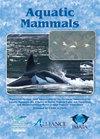两只加利福尼亚海狮(Zalophus californianus)的水下声音探测阈值(0.031-80 kHz)和该物种的修订通用听力图
IF 0.9
4区 生物学
Q4 MARINE & FRESHWATER BIOLOGY
引用次数: 0
摘要
采用窄带调频听力测试信号,记录了两只加利福尼亚海狮(Zalophus californianus),一只成年雌性(F01)和一只亚成年雄性(M02)的行为听力图。信号的持续时间为1秒,中心频率范围为0.031至80khz。根据上下阶梯法,通过改变测试信号幅度来测量听力阈值。由此得到的两只海狮的水下听力图(50%检测阈值)相似,并显示出典型的哺乳动物u形。F01和M02在11.3 kHz和8 kHz时的最大听觉灵敏度分别为58和57 dB / 1 mPa。最佳听力范围(定义为<从最大灵敏度10分贝)从1到16千赫(四个八度)。听力测试信号频率0.031、0.040和0.050 kHz的检测阈值低于预期,可能是由于感知方式从听觉转变为振动触觉,或者是由于在池中难以准确测量如此低频率的SPLs。对粒子运动的测量认为不可能通过触须检测到这些极低频率。目前的研究扩大了加州海狮听力测试的频率范围。基于本研究的两个听力图和Reichmuth et al.(2013)和Cunningham &Reichmuth(2016)提出了一种修订后的加州海狮通用听力图。本文章由计算机程序翻译,如有差异,请以英文原文为准。
Underwater Sound Detection Thresholds (0.031-80 kHz) of Two California Sea Lions (Zalophus californianus) and a Revised Generic Audiogram for the Species
Unmasked behavioral audiograms of two California sea lions (Zalophus californianus), an adult female (F01) and a subadult male (M02), were recorded using narrow-band frequency-modulated hearing test signals. Signals had a duration of 1 s and center frequencies ranging from 0.031 to 80 kHz. Hearing thresholds were measured by varying test signal amplitude according to the up-down staircase method. The resulting underwater audiograms (50% detection thresholds) of the two sea lions were similar and showed the typical mammalian U-shape. Maximum hearing sensitivity (58 and 57 dB re 1 mPa) occurred at 11.3 kHz for F01 and at 8 kHz for M02, respectively. The range of best hearing (defined as < 10 dB from the maximum sensitivity) was from 1 to 16 kHz (four octaves). The detection thresholds for hearing test signal frequencies 0.031, 0.040, and 0.050 kHz were lower than expected, possibly caused by a shift in perceptional modality from auditory to vibrotactile, or due to the difficulty in measuring accurate SPLs of such low frequencies in a pool. Measurements of particle motion deemed detection of these very low frequencies via the vibrissae unlikely. The present study extends the frequency range for which the hearing of California sea lions has been tested. Based on the two audiograms of the present study and audiograms reported by Reichmuth et al. (2013) and Cunningham & Reichmuth (2016), a revised generic audiogram for California sea lions is proposed.
求助全文
通过发布文献求助,成功后即可免费获取论文全文。
去求助
来源期刊

Aquatic Mammals
MARINE & FRESHWATER BIOLOGY-ZOOLOGY
CiteScore
1.60
自引率
16.70%
发文量
99
审稿时长
>12 weeks
期刊介绍:
Aquatic Mammals is a peer-reviewed journal sponsored by the European Association for Aquatic Mammals (EAAM), the Alliance of Marine Mammal Parks and Aquariums (AMMPA), and the International Marine Animal Trainers’ Association (IMATA). Aquatic Mammals publishes articles related to marine mammals (whales, dolphins, seals, fur seals, sea lions, walrus, dugongs, manatees, sea otters, and polar bears). Topics of publication on both captive animals and wild marine mammals include aspects of husbandry; behavior; conservation; veterinary medicine; anatomy; physiology; training; population trends; and the effects of pollution, climate change, and noise.
 求助内容:
求助内容: 应助结果提醒方式:
应助结果提醒方式:


